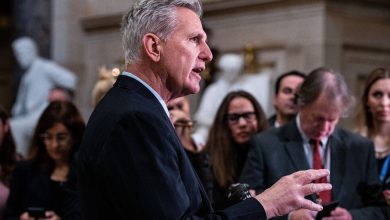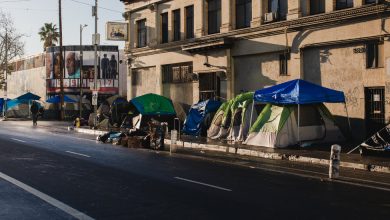Thinking of Going to Southeast Asia? Here’s What to Expect.

Their flights were more expensive and took longer, their favorite restaurant was shuttered and they had to take coronavirus tests on the first and fifth days of their trip. But the biggest hassle for Brian Lamberty and Paola Laird, retirees from London, in their long-awaited return to Phuket Island in Thailand was the paperwork.
Before their February trip, Ms. Laird spent nearly three hours uploading all the documents — vaccination records, hotel reservations, and proof of health insurance among them — needed for the Thailand Pass, an entry requirement instituted for international travelers during the pandemic. “For many people who are not computer literate, it’s going to be a problem,” Ms. Laird said.
After a long and painful hiatus, and despite rising cases of coronavirus in some Southeast Asian countries and lingering United States government warnings against travel to most of them, international tourism is now gradually returning to Southeast Asia. Mr. Lamberty and Ms. Laird are among the early waves of visitors since the pandemic restrictions turned the region’s tourism playgrounds into ghost towns in early 2020. More countries in recent weeks announced that they are ready to admit fully-vaccinated foreign tourists, or soon will be, though still within limits.
The rollout of vaccines in Southeast Asia and rollback of coronavirus restrictions around the world are prompting the reopening. Now, the war in Ukraine is complicating the travel picture everywhere, as the general unease could make people think twice about booking a big trip — or potentially opt for Southeast Asia, 4,500 miles from Ukraine, instead of Europe.
In November, Thailand and Cambodia were among the first countries in Southeast Asia to fully reopen to tourists. After an Omicron surge, Thailand in December suspended most tourist arrivals, but on Feb. 1 resumed its nationwide “Test & Go” program, which requires hotel isolation and a PCR test the first day and a rapid test the fifth day. Days later, Bali fully reopened to foreigners, though with a quarantine of three to seven days (then dropped the quarantine requirement this month). The Philippines followed Feb. 10, with no quarantine but with social distancing in some locations. Vietnam announced that it would open its borders March 15 to international tourists, with a one-day hotel isolation. And Malaysia on Tuesday announced it was reopening April 1 without a quarantine.
As the once tourist-dependent region reopens its borders, travelers should expect more paperwork, higher airfares, cheaper hotels (for the short-term) and less crowds — especially since China, the biggest single source of tourists in the region, has no plans to reopen its borders anytime soon.
Travel operators are grappling with a shortage of labor, lingering uncertainty over the virus and now the war in Ukraine, and impatience — they worry that those deeply missed tourists will go elsewhere in the region unless their own country is the first to fully reopen.
“I think for the next 12 months it’s going to be pretty complicated to travel in Asia,” said Adam Platt-Hepworth, whose Grasshopper Adventures cycling tour company worked with 30,000 travelers in 2019 and fewer than 50 in 2020. “The biggest challenge overall is just going to be restarting after so long, not just with our people but with hotels and restaurants and anyone in travel. It’s been a long time. People are rusty.”
Complications abound for travelers
Before the pandemic, Southeast Asia was one of the fastest-growing regions in the world for international tourism, with a record 139 million visitors in 2019, a jump of about 8 percent compared to 2018, according to the United Nations World Tourism Organization. The emerald waters of Halong Bay in Vietnam were crowded with hundreds of cruise boats, rooftops bars in Kuala Lumpur in Malaysia teemed with partyers and walking on streets on Thai islands like Phuket meant enduring shoulder-to-shoulder crowds. Tourist attractions across the region were congested with package tours from China, the world’s biggest source of outbound tourism for the past decade. According to the U.N.W.T.O., about 150 million Chinese travelers spent $277 billion in 2018 alone.
Countries like Thailand, Vietnam, Singapore and Cambodia were among favorite destinations of Chinese tourists. But as the coronavirus outbreak in China morphed into a global pandemic in early 2020, locations in the region that depended on foreign visitors were deserted. Last year, foreign arrivals to Southeast Asia plummeted to 3.3 million, or around 2 percent of the record number in 2019.
This year, with the incremental revival of international tourism, visitors will encounter a raft of constraints as well as rewards, according to tourists and travel companies in the region.
Mr. Lamberty and Ms. Laird vacationed in Phuket 16 times before the pandemic. They were usually out and about on the island — fabled for its tropical beaches, fiery cuisine, hedonistic nightlife — and enjoyed visiting temples and taking Thai cooking classes. This time, they took it easy, visiting friends and relaxing at their go-to beachfront hotel, Dusit Thani Laguna Phuket on the Andaman Sea. They were sad to see that boutiques had closed in a nearby shopping center, now a Covid testing site.
“You have a memory of what’s happened before and what was here, but everybody has to compromise,” Ms. Laird said. “Be brave about travel and go for it; the prize is just being here.”
Travelers going after that prize should be prepared to endure virus tests and even quarantines, and purchase health and travel insurance before their arrival. Other suggestions: Be ready to download government travel apps, upload vaccination and travel documents, and acknowledge that a positive virus test result could send you into a quarantine or cause a missed flight. Don’t be surprised if service at hotels, restaurants and tour companies is spotty or if they are short staffed — or if the government rules change suddenly while you’re on holiday.
Higher flight costs are another unwanted change. Airfares from the United States to Southeast Asia last month were about 30 percent higher than before the pandemic, because fewer planes were flying to the region, averaging $1,150 round trip, according to an analysis for The Times by Hopper, the flight and hotel booking company.
“Generally, as airlines add capacity to these countries, airfares should drop,” said Adit Damodaran, an economist at Hopper.
However, it’s easy to find a bargain on a room as the region’s wide spectrum of accommodations, from hostels to luxury resorts, comes back. Popular tourist attractions and destinations that were suffering from overtourism, like Phi Phi Leh Island in Thailand, Angkor Wat in Cambodia and Boracay in the Philippines, will be less packed. And while many Western-style restaurants went bankrupt, the options for discovering local cuisines continue to be seemingly endless.
Online booking platforms like Hopper and Booking.com say searches for flights and hotels are on the rise in Southeast Asia. According to Google’s Destinations Insights, searches on Vietnam grew the fastest of all countries from December to February, by 75 percent. International and regional airlines like Singapore Airlines, Thai Airways and Vietnam’s VietJet are returning mothballed planes to the skies.
Slow recovery predicted by operators
Despite these positive indications, most travel operators do not expect a return to the boom year of 2019 this year or even next.
“It may take two years more,” said Le Tuan Kiet, the operations manager for the cruise line Indochina Junk in Vietnam’s Halong Bay.
The company docked all but two of its 16 boats and focused on domestic tourism, which helped keep tourism alive in places like Dalat in the mountains and Vung Tau on the coast. Indochina Junk converted the two luxury cruise ships to domestic day tours with karaoke sound systems and Vietnamese fare, said Mr. Kiet. But those efforts brought only a relative trickle of guests, and most of the company’s 250 workers lost their jobs and went back to their families, he said, and some found work in factories.
Luring them back will not be easy, he said. “They don’t want to move from their hometowns to the city again,” he said.
For Mr. Platt-Hepworth of Grasshopper Adventures, hiring staff is also difficult, as some of the company’s employees pivoted to other work during the pandemic, like opening a bakery in Taiwan and becoming a cycling coach in Vietnam, he said.
During the desolation, his remaining staff of seven, a decimated number from 140 permanent and casual workers, spent months revising an app for self-guided tours, with live-chat messaging, recommendations on restaurants and hotels, and a podcast about the next day’s ride. That was prescient, because as Grasshopper began to offer tours in a handful of destinations last year, “there’s been a surge in interest in self-guided tours, for obvious reasons,” he said.
Keeping tabs on the shifting travel directives for various countries is difficult too. Grasshopper started offering tours first in Sri Lanka, then Thailand, Uzbekistan and Cambodia, where the Nov. 15 reopening was one of Southeast Asia’s least restrictive, just a rapid coronavirus test on arrival.
Varying reopening plans
Despite Vietnam’s March 15 reopening date, Indochina Junk is holding off booking trips until September, mainly to make sure that international airlines restart enough flights, Mr. Kiet said. The company will reopen with only six boats and its three-day cruises will likely be cheaper, he said. If a quarantine is required, he said, guests can do it on the boats.
Vietnam’s reopening announcement came in the wake of a 2021 Delta variant surge that led to a monthslong nationwide lockdown, a switch in policy from zero-Covid to living with the virus, and a stepped-up government push to get the population vaccinated. Its rate of fully vaccinated citizens has reached 80 percent. Even though an Omicron surge in late February was generating a record number of cases, Mr. Kiet was confident the government would stick to the date.
Travel Trends That Will Define 2022
Looking ahead. As governments across the world loosen coronavirus restrictions, the travel industry hopes this will be the year that travel comes roaring back. Here is what to expect:
Air travel. Many more passengers are expected to fly compared to last year. You’ll still need to check the latest entry requirements, and wear a mask for now. But more destinations will be within reach as countries reopen to tourists.
Lodging. During the pandemic, many travelers discovered the privacy offered by rental residences. Hotels hope to compete again by offering stylish extended-stay properties, sustainable options, rooftop bars and co-working spaces.
Rental cars. Travelers can expect higher prices, and older cars with high mileage, since companies still haven’t been able to expand their fleets. Seeking an alternative? Car-sharing platforms might be a more affordable option.
Cruises. Despite a bumpy start to the year, thanks to Omicron’s surge, demand for cruises remains high. Luxury expedition voyages are particularly appealing right now, because they typically sail on smaller ships and steer away from crowded destinations.
Destinations. Cities are officially back: Travelers are eager to dive into the sights, bites and sounds of a metropolis like Parisor New York. For a more relaxing time, some resorts in the U.S. are pioneering an almost all-inclusive model that takes the guesswork out of planning a vacation.
Experiences. Travel options centered around sexual wellness (think couples retreats and beachfront sessions with intimacy coaches) are growing popular. Trips with an educational bent, meanwhile, are increasingly sought after by families with children.
“We need to get the economy going now before the other countries,” he said.
The economic upheaval for Russia brought on by its invasion of Ukraine could mean fewer tourists to Vietnam and Thailand, popular destinations for Russians. For now, “the impact isn’t that clear,” said Nantida Atiset, the vice president of the Phuket Tourist Association.
In Phuket these days, some 2,500 to 3,000 foreigners are arriving daily at the airport, though that’s less than a third of the traffic during prepandemic days, Ms. Atiset said.
“It’s not as packed and crowded as before,” she said. “Now, it’s high season, sunshine everyday, and on average hotels are 35 percent cheaper than before.”
Lush countryside and local dishes still beckon
Ad and Patricia Ketelaars, semiretired Dutch entrepreneurs who moved to Singapore seven years ago, last month decided to take their first adventure trip in the region in two years. They wanted to cycle in Thailand on a self-guided tour, but it was “too complicated,” Mr. Ketelaars said.
They opted for Cambodia and booked a guided tour with Grasshopper Adventures, setting out on Feb. 28 from Phnom Penh and ending eight days later in Siem Reap.
They were most looking forward to returning to the lush countryside, said Mr. Ketelaars just before the trip and in between taking a coronavirus test in Singapore and researching the best hospitals in Cambodia.
“The anxiety of these types of things is, what if you test positive?” he said. “You want to make sure you wind up in a place that can deal with it.”
Michael Williams, a cargo pilot who lives in Wisconsin, plans to travel to Vietnam at the end of this month, to finally meet the woman from Hanoi he has been dating online for a year.
After talking daily for hours on WhatsApp, he and his girlfriend and her daughter will be together to start figuring out the future, Mr. Williams said. They hope to have time for a beach weekend in Danang, and he’s looking forward to trying local dishes and soaking up the history and culture.
He’ll get a booster before the flight, so he’s not worried about an outbreak, and he’s not concerned about Russia’s war on Ukraine as long as it’s contained to Eastern Europe.
“It’s just a matter of making it real and getting there,” he said.
Follow Patrick Scott on Instagram at @patrickrobertscott.

52 Places for a Changed World
The 2022 list highlights places around the globe where travelers can be part of the solution.
Follow New York Times Travel on Instagram, Twitter and Facebook. And sign up for our weekly Travel Dispatch newsletter to receive expert tips on traveling smarter and inspiration for your next vacation. Dreaming up a future getaway or just armchair traveling? Check out our 52 Places for a Changed World for 2022.





